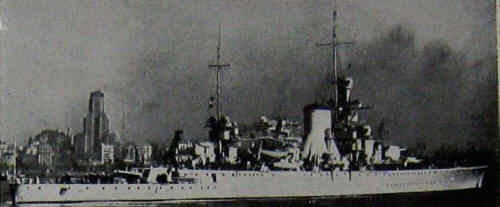
NAVYPEDIA
 Support the project with paypal
Support the project with paypal
Photo

Almirante Brown 1931
Ships
| Name | No | Yard No | Builder | Laid down | Launched | Comp | Fate |
|---|---|---|---|---|---|---|---|
| Almirante Brown | C1 | OTO, Sestri Ponente, Italy | 12.10.1927 | 28.9.1929 | 18.7.1931 | stricken 6.1961 | |
| Veinticinco de Mayo | C2 | 163 | OTO, Livorno, Italy | 29.11.1927 | 11.8.1929 | 11.7.1931 | stricken 3.1960 |
Technical data
| Displacement standard, t | 6800 |
|---|---|
| Displacement full, t | 9000 |
| Length, m | 162.5 pp 170.8 oa |
| Breadth, m | 17.8 |
| Draught, m | 4.66 |
| No of shafts | 2 |
| Machinery | 2 sets Parsons geared turbines, 6 Yarrow boilers |
| Power, h. p. | 85000 |
| Max speed, kts | 32 |
| Fuel, t | oil 2300 |
| Endurance, nm(kts) | 8030(14) |
| Armour, mm | belt: 70, bulkheads: 60 - 40, deck: 25, turrets: 50, CT: 65 |
| Armament | 3 x 2 - 190/52 Odero-Terni, 6 x 1 - 102/45 Odero-Terni, 6 x 1 - 40/39 Vickers-Terni 1917, 6 - 533 TT (beam, 12), 1 catapult, 2 seaplanes (O2U Corsair) |
| Complement | 780 |
Standard scale images

Almirante Brown 1931

Veinticinco de Mayo 1945
Graphics
Project history
To the mid-1920s Argentina had the most numerous Navy on continent, however its cruiser forces hopelessly become outdated. The ten years Naval programme accepted in 1926 with total cost of 75 million peso, provided building of three heavy cruisers. Competition has benefited by OTO, the same year received an order on two ships (the third was financed, but never ordered). Design was developed on a basis of Italian heavy cruiser Trento, but differed by decreased dimensions, main guns calibre, protection and machinery structure. Though cruiser possessed a set of lacks peculiar to Italian shipbuilding school (hull construction weakness, insufficient machinery reliability, congestion by armament), nevertheless, they have allowed the Argentina Navy to go out on qualitatively new level and next two decades have ensured the resolute superiority over navies of the basic contenders, Brazil and Chile. The hull had a bulb and big bow flare, but, unlike a prototype, had a forecastle. Odero-Terni 190mm/52 guns were the forced version of 190mm/45 guns installed on British Hawkins class cruisers. Turrets were designed on the basis of turrets of Trento, guns were in common gun slides with maximal elevation angle 46°. TTs were fixed and placed on a main deck. In a fore end there was "Gagnotto" catapult and underdeck hangar containing 2 seaplanes (originally Vought 02U Corsair, later Grumman G5). Machinery took places by linear scheme. On trials at forced draught ships reached 116000hp and 33.5kts, but in service conditions speed was significantly lower. In 1937 inconvenient in usage catapult was landed from both ships, hangar was used for placing of additional accommodation spaces. In 1939 behind a funnel new rotating catapult was installed; thus the height of funnel was increased, the superstructure form was altered. In 1944 new cranes were mounted. In days of war Supermarine Walrus and Grumman G15 Duck seaplanes were based on cruisers. Both ships arrived to Argentina 15.9.1931.
Ship protection
Protection scheme as a whole repeated Trento, differing in smaller thickness of horizontal protection. The citadel was stretched from bow to aft turret. 70mm belt was closed by 60-40mm transverse bulkheads, and was connected by the upper edge with flat 25mm main deck. Above a belt the side up to upper deck level was protected by 25mm plating.
Modernizations
1937, both: - catapult, 2 seaplanes
1939, both: + new rotated catapult, 2 seaplanes (Walrus); funnel was raised
1949, both: + type 268 radar
6/1950, both: - 6 x 1 - 40/39; + 4 x 2 - 40/60 Mk 1
1956, both: - 6 x 1 - 102/45, 1 catapult, 2 seaplanes; + 6 x 2 - 40/60 Mk 1
Naval service
Almirante Brown was damaged 3.10.1941 at collision with destroyer Corrientes and battleship Rivadavia: repair was lasted 3 months. Both were broken up in Italy in 1962.
 HOME
HOME FIGHTING SHIPS OF THE WORLD
FIGHTING SHIPS OF THE WORLD ARGENTINA
ARGENTINA CRUISERS
CRUISERS VEINTICINCO DE MAYO heavy cruisers (1931)
VEINTICINCO DE MAYO heavy cruisers (1931)

